New York Gov. Kathy Hochul called it “a glimmer of hope.”
The number of new COVID-19 infections in New York City has begun to plateau in recent days and the percentage of COVID-19 tests resulting in a positive diagnosis has fallen sharply.
On Monday, the city’s seven-day average rate of new COVID cases dropped to 32,000 infections daily, a 20% decline from the previous week.
“Looks like we might be cresting over that peak,” Hochul said the next day.
The Washington Post reports that a similar dynamic is occurring “along the Interstate 95 corridor from the Mid-Atlantic to New England”:
Coronavirus levels in Boston-area wastewater are falling, a promising sign because alarmingly high levels spotted earlier presaged record infections. The Children’s Hospital of Philadelphia has seen the rate of teachers testing positive during asymptomatic weekly screening plunge from 25 percent in the week between Christmas and New Year’s to 2 percent in recent days.
Forecasters are expecting similar trends in the Mid-Atlantic, where infections have been slowing in the District and Maryland, but the ongoing strain on hospitals prompted officials to declare emergencies.
“You got a picture of an East Coast that’s rapidly improving, a Southeast that’s not far behind, a Midwest that’s maybe a week behind the East Coast while the West Coast has not yet peaked. Our assessment is we have likely peaked as a country,” said David Rubin, who tracks national coronavirus trends for PolicyLab at the Children’s Hospital of Philadelphia, to The Post.
The New York Times adds important context:
A huge surge in cases that lasts for about one month, followed by a rapid decline, would be consistent with the experience in some places where Omicron arrived earlier than in the U.S. In South Africa, new daily cases have fallen by about 70 percent from the mid-December peak. The chart showing South Africa’s recent trend looks like a skinny, upside-down letter V.
In Britain, where pandemic trends have frequently been a few weeks ahead of those in the U.S., cases peaked just after New Year’s and have since fallen somewhat.
Since COVID-19 deaths and hospitalizations lag new infections, hospitals in the Northeast are still experiencing an intense strain. And Lauren Ancel Meyers, director of the University of Texas COVID-19 Modeling Consortium, told The Associated Press, “There are still a lot of people who will get infected as we descend the slope on the backside.”
“The next few weeks are going to be brutal because in absolute numbers, there are so many people being infected that it will spill over into ICUs,” Dr. Prabhat, Jha of the Centre for Global Health Research at St. Michael’s Hospital in Toronto, told the AP.
Tom Frieden, a former Centers for Disease Control and Prevention director, told The Post, “We know that the more people who are up to date with their vaccines, the fewer deaths there will be, the fewer hospitalizations there will be and the less economic disruption there will be.”



